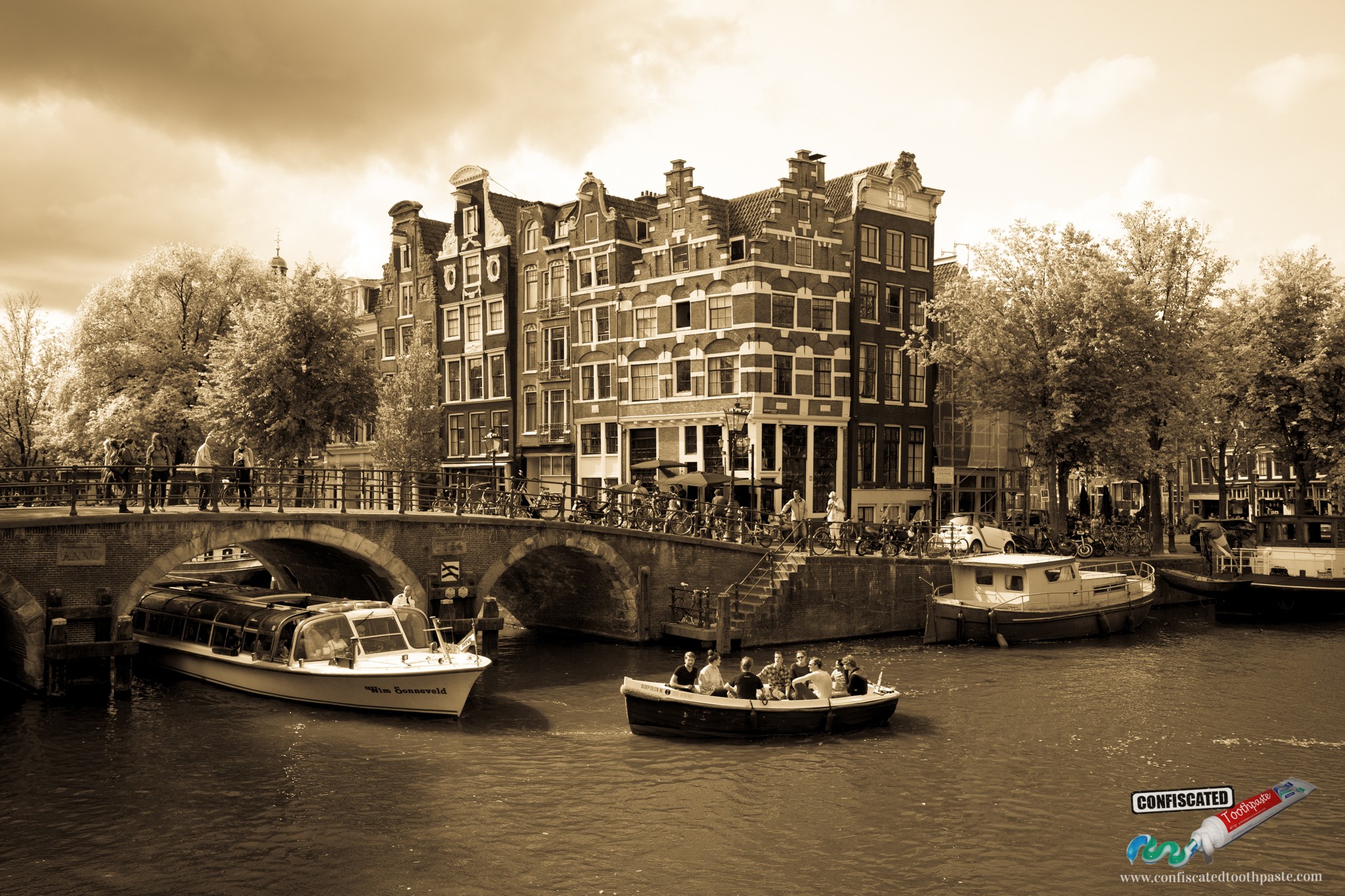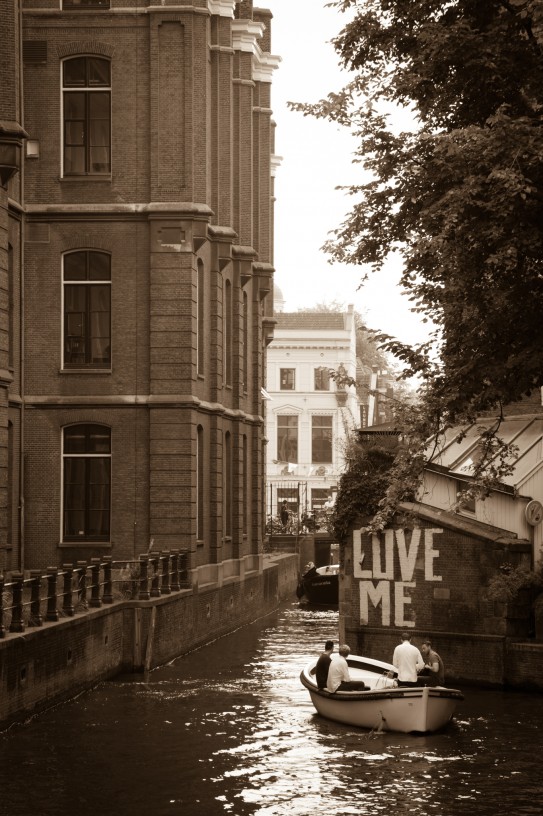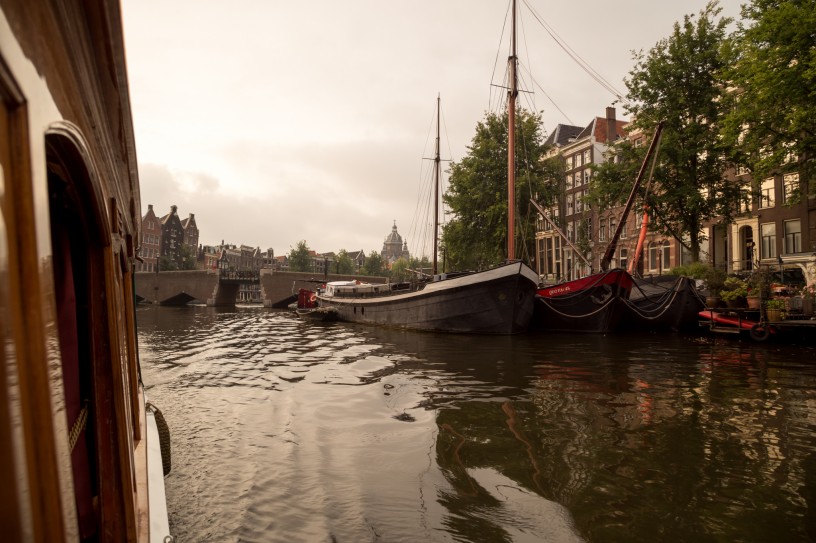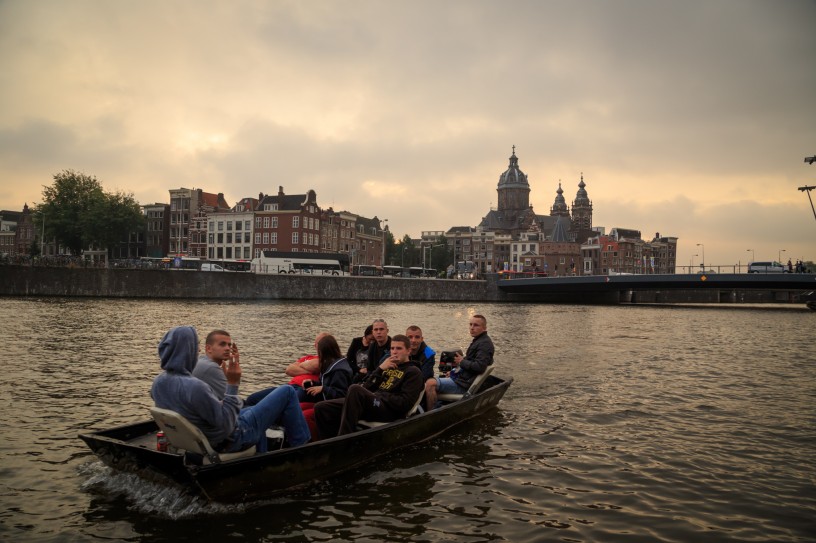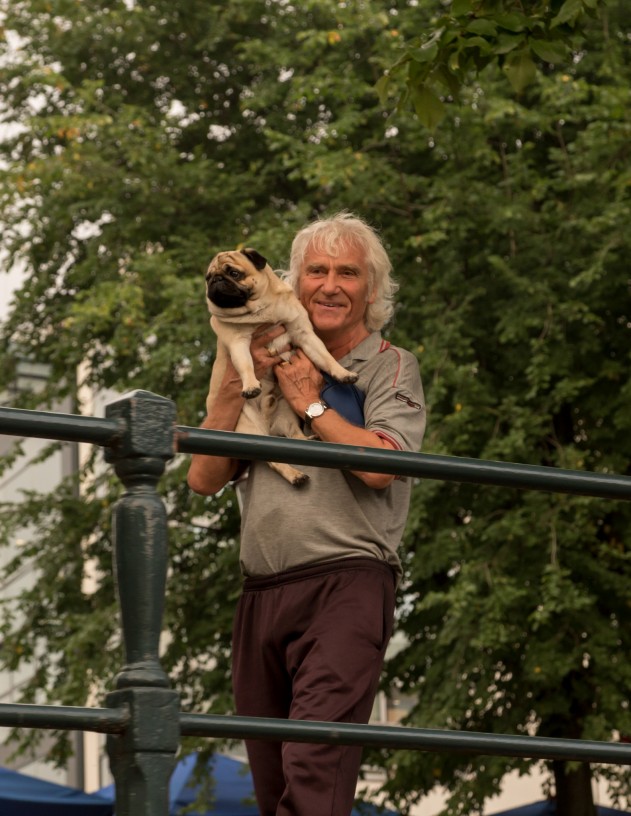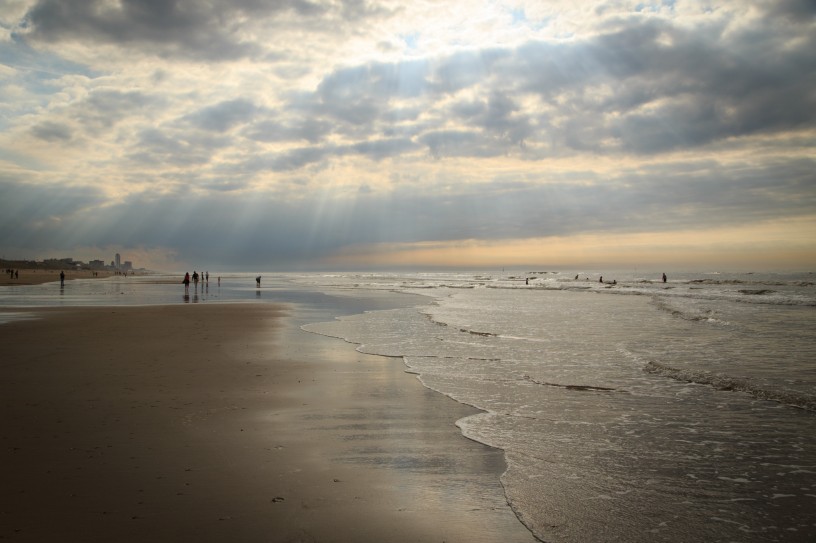A Roadtrip Through The Netherlands and Belgium
Part 1: Amsterdam, Haarlem, The Hague and Zeeland
The Netherlands and Belgium? They’re flat as stroepwafels, rather small and half under-water. Who’d want to go there when you could visit the surrounding France, Germany or the UK? Me! The lowlands of Europe are oft-maligned yet among the best ye olde continent has to offer. If you enjoy canals, cheese, bikes, very tall blonds or geoengineering then you’ll enjoy the Netherlands, while if waffles, beer, chocolate, medieval villages or national disunity are your bag then you’d really dig Belgium. I’ll be honest- all of those things appeal to me, which is why my roadtrip through The Netherlands and Belgium was so long overdue.
Amsterdam

Wow- I can’t believe I’m here. Whether it’s the day(s) of transit or the craziness of the city, or the fact that I was once here 17 years (half a lifetime) ago– I can’t be sure.
I’ll be spending most of my week in Amsterdam aboard a houseboat on the Amstel River, so I decide to start the week in style. The houseboat is slightly out of the city centre close to a conference I am attending, so for the first night I check into the stunning Pulitzer Hotel, close to the city centre. It’s in the De Negen Straatjes (“The Nine Streets”) area of Amsterdam, a central shopping area dissected by 3 major canals.

The Pulitzer is on the prestigious Conde Nast Top 25 Hotels in Northern Europe and it does not disappoint. It’s an amalgamation of 25 restored 17th and 18th century canal houses, and I have ordered a room overlooking the canal outside. The view is enchanting and the room is as character-filled as I hoped, with rough-hewn beams in the ceiling and large picture windows. It is also luxurious, and after a long trip from Sydney the bed with its soft fluffy pillows is heavenly. There are also chocolate truffles in small gable-house-shaped boxes. I know that it’s the Belgians with the reputation for good chocolate, but these taste pretty damn good also.
Surprisingly, since winter is approaching, the weather is unseasonably warm and the sun is out. This is not lost on Amsterdam’s locals, who are out in force at cafes and on boats in the canals. It’s Saturday afternoon and the exuberance of the city is immediately obvious- it’s like everyone has come out to party. I watch as an endless procession of boats goes past. One has what looks like a group of students making merry with a box of beer, the next has a group of people dressed as pirates, and the next has a group of gay men engaged in a sex act.
The city centre is no less eye-opening. Around Dam Square, crowds of chatting people sit chilled out on the cobblestones, while others dodge hordes of bikes, trams and every other form of transport you can imagine. I walk through the red-light district of De Wallen, where whores stand behind shop-windows and the smell of burning marijuana wafts from coffee shops. A postcard on a rack obnoxiously proclaims “In Amsterdam, we eat, sleep, drink, get stoned and fuck”. Sleep seems the most attractive option right about now, so I return to the Pulitzer for an afternoon nap.


The hotel has an impressive canal boat moored out the front. With its 1920s style polished teak and brass, adorned with marble, leather and bevelled glass, it is apparently the very same vessel Winston Churchill chose to tour Amsterdam in 1946. It looks the part, and it’s about to leave on a tour of Amsterdam’s canals. I decide to fight against my urge to continue sleeping, and get a further introduction to Amsterdam by water.

The canals are truly spectacular and our captain is knowledgeable, waxing lyrical on various buildings, bridges and landmarks. We past under countless curvy bridges and countless boats full of merry makers. I am leaning out of the boat, taking some photos of a crooked house, when someone on the bank yells out “Oi Matt!” in an Aussie accent. It’s Brett, a colleague who will be staying in the houseboat with me, and I’ve chanced upon him drinking beers in the sun. Now I know Amsterdam is not a huge city, but the coincidence is still pretty remarkable. “Do you want me to let you out?” the captain asks me.
“Nah,” I reply.
The sun goes down and the city assumes a dreamlike state. We pass into the ocean waters beyond the train station, which sits on reclaimed land. We then drift down the Amstel River, lined by houseboats, one of which will be my home for the next several nights. But for now, it’s an early night and room service at the Pulitzer.

Amsterdam is chock-full of popular museums and there are two I want to see- the Van Goph Gallery and Anne Frank House, where a Jewish family spent several years hiding from the Nazis after the Netherlands was occupied in the war. I get to Van Goph early on Sunday morning and to my delight, there’s barely even a queue. Seeing all those incredible paintings, from Sunflowers to the Potato Eaters is arresting, as is the news (to me) that most of Van Goph’s superlative output occurred within a 10-year period.
Unfortunately, I am not as lucky with Ann Frank House, with online tickets booked out weeks ahead and queues of several hours being present at all times I walk past during the next week. Let this be a lesson to book ahead!

Before heading to the houseboat, I take a long walk through the Jordaan area of Amsterdam. A former crowded slum, it’s now reborn as a home for artists and entrepreneurs, and is very peaceful in comparison to the rest of the bustling centre. I have lunch in Café Mothers– so called because the room is filled with framed portraits of mothers. I eat dutch sausages, potato and sauerkraut and apologise for not having a picture of my mother to leave there.


I take a cab across town to meet Barak, the houseboat owner. But Brett has got there first and Barak has already left and Brett’s naturally claimed the biggest bedroom. The boat is not much to view from the outside, but inside is a pretty impressive loungeroom complete with portholes. My room is up under the stern of the boat, below the engine which looks like it hasn’t run in about a decade. Barak has also rented us bikes at 10 euro a day, and they sit outside chained to the mailbox.
Life on the houseboat is comfortable and fun- we start each day looking across the still expanse of river and finish each night with the boat swaying us to sleep. The weather however deteriorates and becomes drizzly and cold- a reminder that winter is not far off.
Each day we ride our bikes to the conference, to bars, and to the other houseboat where our colleagues are staying. Theirs is a fair bit bigger than ours- more house than boat, and it looks like it’s been stationary even longer than ours. As it happens, owning a houseboat is not cheap- it’s a bona-fide alternative to owning a house, though with comparable capital requirements. It’s a way of life here for many locals.
Our bikes allow another modicum of local life. Amsterdam has a reputation as a bicycling city, but the quality and quantity of bike lanes and people on bikes is simply mindblowing. I get stuck in peak-hour bike traffic jams and lay eyes upon a three-storey bike parking lot. The bicycle is king here.




Midway through the week, Ed arrives. Ed is coming on the roadtrip with me and is an ex-colleague of ours. He sets up camp in the third room of the houseboat. On our final night in Amsterdam we bike into the city centre and go bar hopping. By night, the city is all bridges and fairy-lights and exudes magic. I’m so enchanted (and a bit tipsy) that, following 4 other bike riders, I ride straight into the path of a car, the riders and the car all skidding the brakes and somehow, all barely avoiding collision. With so many forms of transport criss-crossing Amsterdam, one has to be ever-vigilant when out and about.
Lo and behold, on the day we leave Amsterdam, it’s a sunny Saturday again, and we continue to defy the impending winter. We meet Barak to give him back his houseboat and bikes before picking up our car (a Renault) and heading for Haarlem.

Haarlem

We’ve allowed an hour to drive to Haarlem, including time taken up getting lost on the way out of Amsterdam. Though we do take a couple of wrong turns, we lose barely ten minutes before we’re on the freeway, and it seems like we’ve been on the freeway 5 minutes before we’re taking the exit for Haarlem. And therein lies the beauty of Netherlands/Belgium- it is so bloody compact. Most train routes do not follow the coast, and with the coastline such an interesting jumble of dykes, islands, colossal engineering projects and seaside resorts, it’s a great place for a roadtrip where you won’t need to spend hours in the car each day.
We use the old “this street looks main-ish” technique to arrive in Haarlem centre, park the car and get out for a walk. Haarlem sits upon the River Spaane, with life centred around the Grote Markt (Great Square) with its impressive Grote Kerk (Great Church) of Saint Bavo. To our delight, the weekend markets are on, and the Square is full of little stalls with delicious bakery treats. We haven’t had breakfast yet so we gorge on pizzas and hot meaty pastelles. The tourist office is in the square and is notable for trying to make money off their 1-page maps- when we try to take one we’re informed that it’s 50 cents. I then embarrass myself by asking how we get to the tulip fields. The lady just laughs and tells me that the tulips are only out in the springtime. Right- makes sense.
We take a wander through the Grote Kerk, and then through beautiful neighbourhoods with small houses and beautiful flower-lined small pedestrian streets. The Adriaan Windmill, which sits atop a house, features prominently on the Haarlem skyline. But we won’t be staying; we’re heading out to the Dutch coastline and then to The Hague.



We jump back in the car and drive out to the beach at Bloemendaal, where we sit in the beach club and eat apple pie and French fries (hot chips). Whether they originate in France, Belgium or Netherlands I really don’t care, but they do have them down to an artform around here. They are golden and crispy and delicious and of course come with mayonnaise for dipping. And the apple pie is sensational too.


The Hague (Den Haag)
On the way to Den Haag, as The Hague is called by all but the most English speaking of English-speakers, we have a chit-chat about our roadtriply duties. It turns out Ed hasn’t driven much since he lived in Sydney 8 years ago, and he also admits that he can’t reverse park. But his navigation skills are good, so we settle on me being the driver and him navigating. Being two male scientists, we talk a lot about girls and electrons and lasers and stuff. It seems like no time at all before we roll into Den Haag.
We pull up at the first hotel we find, which is full, and ask for recommendations. We end up at the Hotel Sebel on Prins Hendrikplein, which is basic but comfortable and most importantly, central. It’s Saturday night and we’re keen to party, so we head out to the town square, rationally called “Plein” (Square). It’s packed with party people, who spill out from the bars into the square itself, and we have a good few hours in a nightclub with good drinks and many very tall blond Dutch women. Unfortunately, the Dutch have not yet caught on with progressive smoking laws and the place is absolutely toxic with smoke. We return home with our clothes and lungs reeking of nicotine. It’s been quite a first day of our roadtrip.


The next morning, we head to the beach at Kijkduin, where we have a swim, before driving to Scheveningen, where there’s a grand hotel on the beach with restaurants and boardwalk. The coastline is broad and flat, and gives a good idea of the low-lying nature of the country. At Scheveningen we find a restaurant with Wi-Fi, because I need to make a work conference-call. The waitress thinks it funny that I’m on the phone all lunch, and she ends up showing us around Den Haag later that afternoon.
We visit the Binnenhof, where the Dutch government sits. It’s a spectacular castle reflected in the Court Pond. We have hot chocolate and soup in the other fun square, Grote Markt, filled with tables and chairs and merry-makers of all kinds, and then my personal favourite, the Peace Palace, where the International Court of Justice sits.
I take a walk on my own after dinner, and come across a street party where a geriatric old jazz band is playing and people are dancing. There’s plenty more to see in this surprisingly cool city, but we’re running short of hours. In the morning we are leaving for Bruges and Belgium.


Den Haag to Bruges via the Islands of Zeeland

The second day of driving dawns and it’s going to be a beauty, plotting a course along the coastline of Zeeland where the Dutch fight a constant battle to keep the ocean out. They haven’t always succeeded- in 1953, a combination of a high spring tide and a storm surge flooded 1,365 km² of land. The ocean covered about 9% of the entire Dutch farmland, and 1836 lives were lost in the great North Sea Flood. (Over 300 lives were lost in the UK as a result of the same surge.)
Since 1953, a network of dams and dykes known as the Delta Works was built to protect Zeeland, most of which is below sea level. We plot a course out of Den Haag, but rather than turn south towards Rotterdam, we head onto the N57 which proceeds across Goeree-Overflakkee in South Holland to the islands of Zeeland.
For a couple of scientist-engineers, the route is spectacular to say the least. A landscape of heavy industry gives way to green farmland and the most colossal engineering works. We stop to have a look at the Haringvlietdam, a set of sluices across the mouth of what eventually leads to the Rhine, and marvel at the different level of water on the sea-ward side to the land-ward side. But the highlight of the day is the Oosterscheldekering (Eastern Scheldt storm surge barrier) which stretches for 9 km and took more than 10 years to build.


The landscape is also dotted with enormous wind turbines, and one of them is being serviced by a crew of technicians. We pull up and ask whether we can have a look inside, mentioning that we are in the solar power industry. They are happy to oblige, though because the turbine is operating, we can only enter the bottom of the mast and cannot travel to the top. This is impressive enough, with the sight and sound of the (utterly massive) blades swooshing through the air from directly below being awe-inspiring.

As if we weren’t already astonished enough by mankind’s civil engineering prowess, we travel length of the Westerscheldetunnel, a 6.6 km tunnel linking the islands to south Zeeland and Belgium. We’re not far from the Belgian border now, and because we’ve enjoyed so many stops on today’s trip it’s fast approaching the time I am supposed be in another phone conference from the hotel in Bruges.
But then we pass by a little theme park on the side of the road with a large windmill and a maze formed from crops of corn. Ed wants to stop.
“No,” I say, “we must press on Ed.”
“But don’t you want to run around that maze?”
“Kind of. But we don’t have time.”
“Come on Matty. We have to do this. It’s a maize maze.”
I clench my teeth- the man has a point. “Shit. You’re right.” And I pull the car violently into the gravel parking lot, where we positively bound into the little ticket shop.

The pretty dutch girl behind the counter asks where we’re from and where we’re going, but unfortunately there’s no time to chat, and we grab our tickets and run into the corn. We get ourselves well and truly lost and pose for photos with corn cobs and by the time we get back in the car, the heat is really on. “It’s ok,” I say, “if nothing goes wrong we should still have enough time.”
At that point, it begins raining torrentially. We cross the border into Belgium, but visibility out the windscreen is almost nil. I’ve heard so much about the amazing medieval Bruges and assume it must be well-signposted, but it doesn’t seem to be. I guess to the Belgians it’s just a small town in Flanders. There’s a whole bunch of roadworks and somehow, inevitably, we miss a critical turnoff. We’re heading towards Ghent rather than Bruges, damn it!

After some miles on the freeway, we find somewhere to chuck a U-turn and double back. We’re pointing at Bruges, the rain still teeming down, and half an hour added to the trip. But I still don’t panic, because we’ve booked ahead of time, and the hotel website loudly proclaimed “FREE WiFi in all rooms and public areas”. Nothing could possibly go wrong, right?
…… Or COULD it? You’ll just have to read Part 2 to find out, when we’ll conclude this adventure in “A Roadtrip in The Netherlands and Belgium Part 2: Bruges, Ghent and Brussels“. In the meantime, I’d love to hear from you below.

